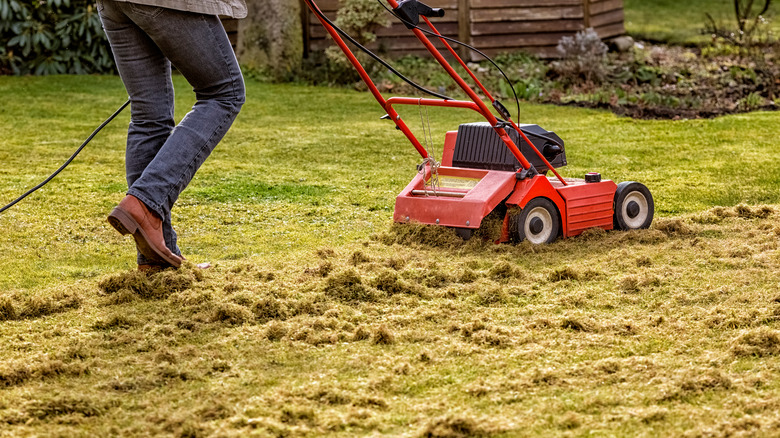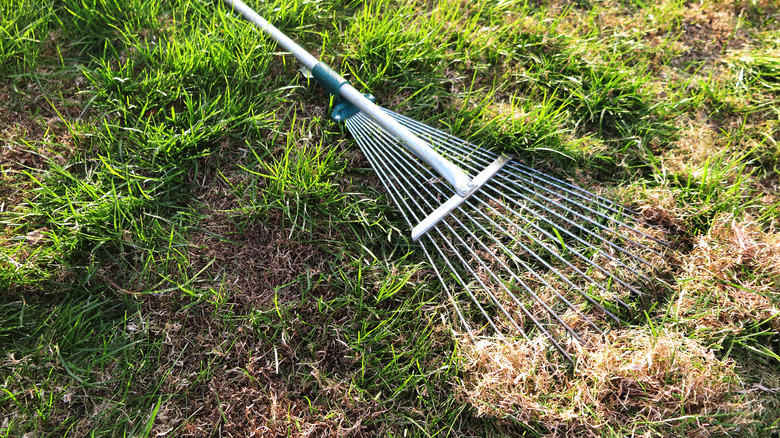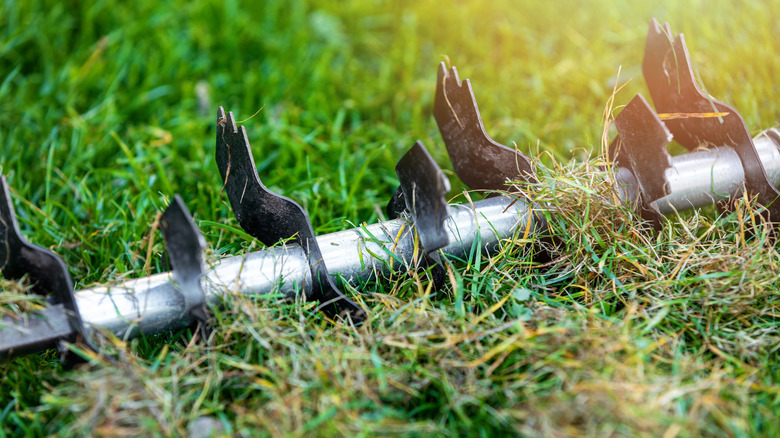What To Know About Scarification For Your Lawn
Growing a luscious lawn can take some work. Aside from proper weed control and mowing, it's crucial to also pay attention to what's happening just beneath the blades of grass. Below the green turf is a fibrous collection of organic matter, including living and dead stems, roots, leaves, and other materials referred to as thatch. According to Mission Green Services, a thin layer of thatch can be beneficial by helping to maintain moisture and temperature for the soil, but amounts thicker than a half inch or so can be a hindrance to proper fertilization, aeration, and water absorption.
Garden Seeker explains that thatch contains lignin, an organic polymer that tends to build up and breaks down slowly. Lignin serves many functions, one of which is to provide rigidity and form, says Science Direct. Microbes, fungi, and bacteria in the soil naturally break down this layer, but not always at the same rate as new grass grows, which is where a problematic cycle begins and lush lawns become scraggly. This buildup leads to a thick, troublesome layer of thatch and compacted soil that can be rectified by a process called scarification, also known as de-thatching.
How to know your lawn has a thatch problem
As a simple measure of lawn maintenance and routine care, Treehouse recommends scarifying your lawn at least twice each year — before and after winter. This process, Treehouse says, readies the plants for winter dormancy and prepares for healthy growth come spring. If de-thatching is performed in summertime, it will help grass to grow thicker and may solve problems with a thinning or sickly lawn.
Poor water absorption is an indicator that your lawn needs scarification. Make a determination by examining the thatch layer. NG Turf says to cut into the soil about an inch deep by using a wide knife or hand hoe. Carefully peel pack the grass to reveal the roots mesh area between the grass and soil. If the layer is thinner than half an inch, then your lawn issue is not caused by thatch overgrowth. However, anything thicker means your lawn is being choked and cut off from nutrients, and scarification is necessary to return the turf to a healthy state.
Tips for successfully scarifying your lawn
The Salutation explains that some scarifiers have blades (designed to cut deeper into the soil to break up moss and thatch) while others have tines (rake-like, often with a small motor, designed to work on the surface of the lawn). These tools can be manual, gas-powered, or electric. There are also herbicides on the market that can help with the dethatching process.
The type of mechanical scarifier tool you need depends on the size of your lawn as well as the amount of debris (fallen leaves and sticks) that typically accumulates in it. For a smaller area with light debris, a handheld scarifier or yard fork will probably suffice, says Mower Guide Pro. Larger areas are easier to manage with a gas or electric scarifier. Lawn preparation, which may include raking leaves, picking up debris, and mowing overgrown turf, will be necessary before using any type of de-thatching tool.
Some tips from Mower Guide Pro include wetting the grass before using the scarifier and making sure you overlap each pass across the lawn with the tool to ensure thorough de-thatching coverage. They also recommend cleaning up the tilled moss and thatch and applying a lawn fertilizer afterward. Scarification can seem like a big job, but with the right tools, it's a task that can be done in a day's work that will reward you with seasons of beautiful and healthy greenery.


